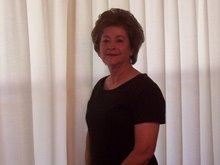When I saw the above headline, I remembered writing this article several years ago. I dug it out of my documents to post here. I've pushed a lot of paint the last 35 years, and I've been aware for a long time about 'The Healing Side of Art'.
The Healing Side of Art
by
Frances Bennett
Have you ever seen pink bulls grazing in the early light of dawn? Would you like to glimpse a pink world for a little whole and record it on canvas?
The sun is rising over our farm this morning, making its way through a colored fog and shedding pink light over everything it touches. The farm buildings have a rose colored glow, and two Charolias bulls grazing in a pasture behind our house look as if they are outlined in iridescent pink.
I am seeing this through the eyes of an artist. I find myself critiquing the Lord’s artwork, analyzing every cast and grade shadow, attempting to sear the image into my being.
There is one other thing I need to see before the light changes. I hurry to a front window and look across the field to my neighbor’s home. I know what I will see, but I never tire of this scene. Her windows are aflame with the reflection of sunrise.
After a while, the brilliance begins to fade, and I reluctantly let it go. I will tuck this memory away and call on it another day when I paint. I am comforted, imagining how this would look on canvas. I turn from the window to begin household chores. I automatically work, and my thoughts go back several years to the weekly adult oil painting class I taught.
My friend, Jeanette, was always the first one there. She helped me get things in order from the children’s class and put clean newspaper on the tables. We usually had a few minutes before the others arrived. Sometimes, she talked about the death of her husband in a nursing home fire, and how she looked forward to painting each Thursday. As the weeks passed, I watched her relax and become totally engrossed in her work.
During class, I made rounds periodically, checking the work of each person in order to catch mistakes in the early stages. I’d known most of my students for years, and one night as I stopped at each table, I suddenly realized how many tragic stories were in that room. I was grateful to have a small part in helping these people put their troubles aside for two hours and be in their own world, a world where color leaps out at you and things come to life on canvas.
Rubye had a heart condition and was diabetic. She came to class with red and swollen feet, but her smile was always there. When she died, one of her class paintings rested on an easel beside her casket. After the visitation, I had a lump in my throat that I couldn’t swallow. I cried all the way home. That lump wasn’t much better the day I packed her art supplies to send to her family.
Leon was the only man in class. We teased him and told him that he put a damper on our conversations. He was in constant pain, but this didn’t stop him from having a good time. It was painful for anything to touch his arms, so even in winter, he wore short sleeves. Several times during class, he stopped painting and exercised his arms and hands. I placed his floor easel by the heater where he stood to paint.
Every few weeks, the subject came up of how art had caused everyone to see colors differently, and how they noticed things they always knew were there, but had never really seen. They sometimes painted at home and brought their work for me to critique.
Jeanette had taken art for a year when her son died. We were on a holiday break, and his death was during this time. She asked if our Antioch Church of Christ group would sing. We gladly did so, and resumed painting after New Years. Jeanette was glad to be back, and told us how she wished for art classes following his death.
My students learned to paint wind-blown skies with ochre fields of waving grass. Their imaginations soared, sometimes adding an old fence, far-off birds in flight, or a hollow tree. I told them to be nervous as they added squiggly branches to the larger limbs. They responded that it would be easy, because they were already nervous. I noticed as class progressed, their hands were much steadier and they were more relaxed.
Now and then, someone created a happy accident. Although they didn’t have enough experience to recognize it, after I explained what they had done and why they should leave it, their self-confidence had a big boost. I assured them that with time, they would know instantly.
I’ve touched on the lives of three students, but there are untold stories concerning the others. There is great satisfaction in seeing the amazement of people as they realize they are actually learning to paint. But the greatest gift of all, is seeing the inner peace that comes through the healing side of art.
Saturday, September 4, 2010
Art Therapy Helps Wounded Soldiers
Labels:
art therapy,
canvas.,
critique,
deployment,
psychological wounds,
therapy,
wounded soldiers
Subscribe to:
Post Comments (Atom)


No comments:
Post a Comment